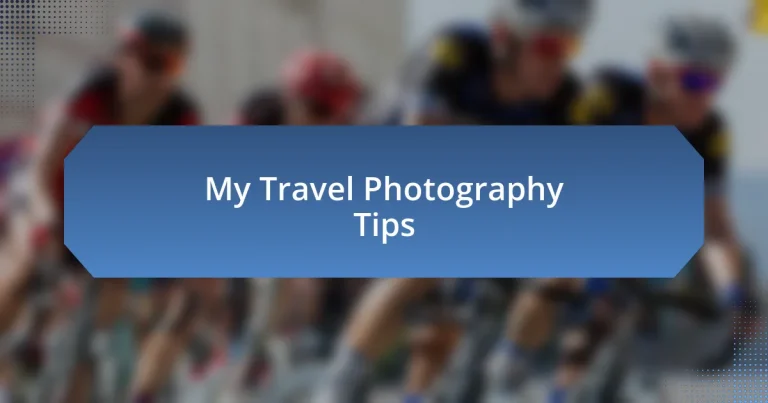Key takeaways:
- Choosing the right travel photography gear includes a high-quality camera, flexible lenses, and essential accessories like batteries and memory cards.
- Planning your photography route and being flexible can enhance your chances of capturing stunning images, taking advantage of golden hour lighting.
- Mastering different lighting conditions and effectively editing your photos can significantly impact the final results and emotions conveyed in your images.
- Sharing your photography online involves vulnerability and storytelling, allowing you to connect deeper with your audience while amplifying your reach.
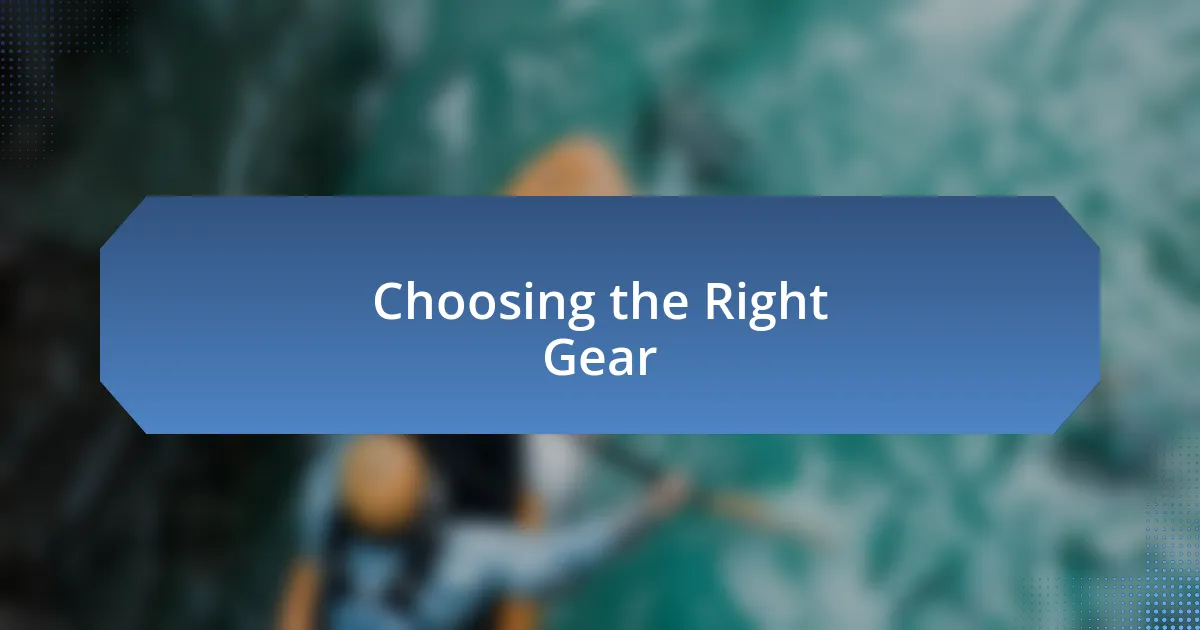
Choosing the Right Gear
When it comes to choosing the right gear for travel photography, I always start with my camera. I remember the first time I went on a trip with my new DSLR; the excitement was palpable. I wondered if I’d made the right investment. A high-quality camera body is essential, but don’t overlook the lenses. They can make or break your shots, allowing for flexibility in various lighting and scenes.
Weight is also a significant consideration. I’ve been in situations where my backpack felt like a lead weight, making me question my packing choices. It’s crucial to find a balance between having the tools you need and being able to carry them comfortably while exploring. Have you ever missed a shot because you were too exhausted to lug around your gear? Investing in a lightweight lens and a good camera strap can genuinely enhance your experience.
Lastly, I can’t stress enough the importance of accessories. Think about extra batteries and memory cards – they can save a trip from becoming a missed opportunity. I recall a moment in Venice where my battery died just as the sun was setting over the canals. It was heartbreaking. So, always ensure you’re prepared; the right gear can make all the difference in capturing those unforgettable moments.
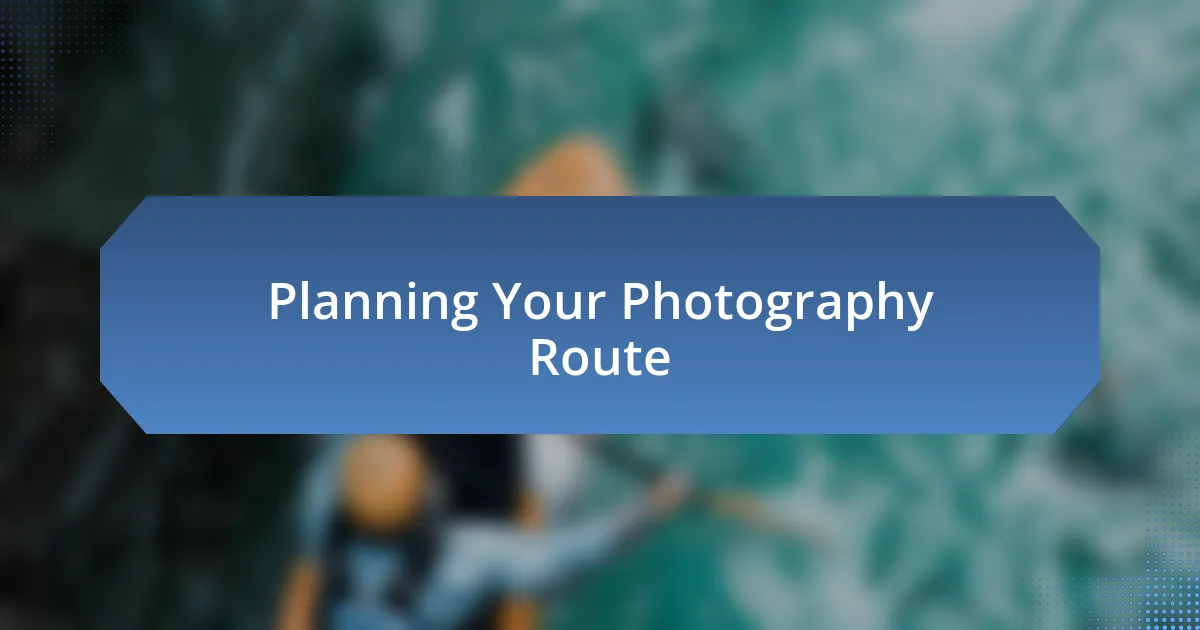
Planning Your Photography Route
When planning your photography route, I often find it beneficial to sketch out specific locations that inspire me. I vividly remember a trip to Iceland where I mapped out stunning waterfalls and dramatic coastlines. Having a visual roadmap not only helps in maximizing the time spent shooting but also ensures that I don’t miss out on hidden gems. Have you ever stumbled upon a breathtaking scene simply because you were wandering without a plan? That serendipitous moment is fantastic, but as a photographer, I love giving myself a fighting chance to find them.
It’s also essential to consider the time of day for each location. Early mornings and late afternoons, known as the golden hours, offer the most magical light for photography. On a visit to the Grand Canyon, I woke up at dawn, and the ethereal glow of the sun rising over the ridge was breathtaking. Without prior planning, I might have missed that surreal moment of tranquility. By planning your route around these times, you significantly enhance the quality of your images.
Lastly, I recommend being flexible with your plans. There were occasions during my travels where weather conditions or unexpected events changed my initial route. Recently, I found myself in Barcelona during a sudden downpour, which could’ve been a setback. Instead, I embraced the rain and snapped some unique street photos that turned out to be my favorites. By allowing room for spontaneity, you may find that some of the best photographs come from unplanned moments.
| Key Considerations | Personal Experience |
|---|---|
| Research Locations in Advance | Mapped stunning sites in Iceland for optimal shooting. |
| Plan for Time of Day | Chased golden hour sunrises at Grand Canyon. |
| Stay Flexible | Embraced unexpected rain in Barcelona for unique photos. |

Techniques for Capturing Landscapes
When capturing landscapes, composition is key. I often use the rule of thirds to guide where I position elements in my frame. This compositional technique can bring balance and make landscapes more engaging. For example, while photographing the rolling hills of Tuscany, I made it a point to place the horizon along the upper third of the frame, allowing the vibrant green fields to dominate the image. It transformed a simple landscape into something truly captivating.
Here are some additional techniques I recommend:
- Leading Lines: Utilize natural lines, like roads or rivers, to draw the viewer’s eye into the scene.
- Foreground Interest: Include elements like rocks or flowers to establish depth and context.
- Framing: Use trees, arches, or other structures to frame your subject, adding layers to your composition.
- Experiment with Perspectives: Changing your viewpoint can drastically alter the way a scene feels; crouching low or finding a higher vantage point can lead to stunning results.
- Timing: Capture landscapes during different seasons or weather conditions for unique moods and atmospheres; shooting a misty morning in the mountains can evoke a sense of mystery.
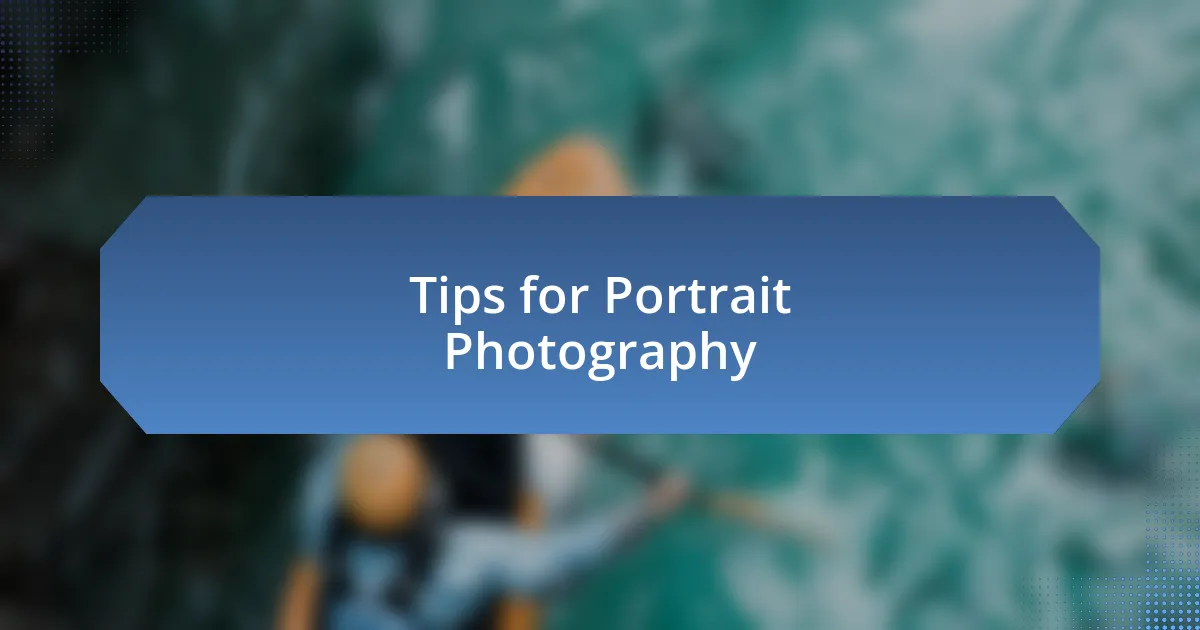
Tips for Portrait Photography
Portrait photography holds a unique challenge, one that often excites me. I find that establishing a connection with my subject can dramatically enhance the final image. When I photographed a friend during a golden hour session, I made an effort to engage her in conversation. It helped her relax, allowing her true personality to shine through. The result was a portrait that felt candid and alive, rather than stiff and posed.
Lighting plays a pivotal role in portrait photography, and I’ve learned to embrace natural light as much as possible. On a recent trip to a bustling market, I noticed how the soft light filtered through the canopies created beautiful highlights on people’s faces. I positioned myself so that the light fell gently on my subjects, capturing truly flattering images. Have you ever thought about how the time of day influences the quality of your portraits? Early mornings or late afternoons offer that lovely golden glow that can elevate your photographs.
Additionally, don’t underestimate the power of background and context in your portraits. The setting can tell a story about your subject. When I took portraits of a street musician, I opted for a backdrop that included their instrument, vibrant street art, and the energy of the crowd. It added layers of context, making the portrait not just a picture of a person, but a snapshot of their world. I often ask myself: How can the environment contribute to portraying the essence of the individuals I am photographing? By considering this question, I find that my portraits become richer and more compelling.
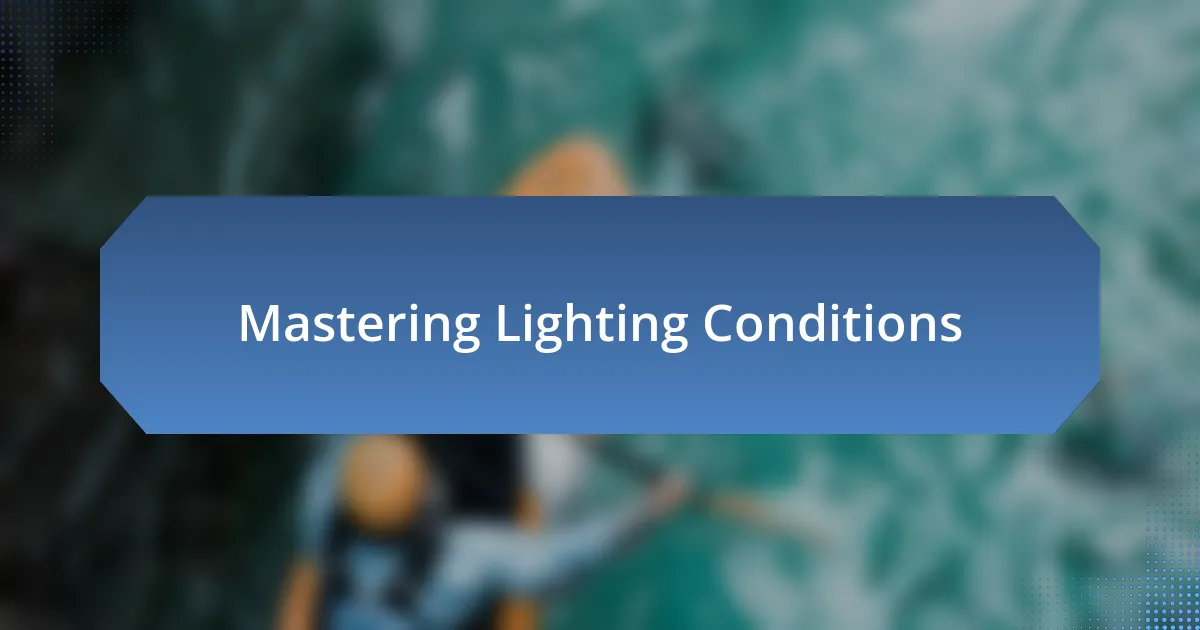
Mastering Lighting Conditions
Mastering lighting conditions is essential for stunning travel photography. I’ve often encountered challenging situations, like that time I was at a scenic overlook during midday. The harsh sunlight washed out the colors and created unflattering shadows. Instead of packing up in frustration, I used my trusty reflectors to bounce some light onto my subjects, which softened those shadows and created a more balanced exposure. How have you tackled difficult lighting situations on your travels?
When shooting in different environments, I always pay attention to how sunlight interacts with various surfaces. A memorable moment for me was photographing a vibrant sunset over a beach in Bali. I noticed how the warm golden light reflected off the water and sand, creating a magical glow that enhanced my images. I positioned my subjects so that the sun was just behind them, resulting in a stunning rim light effect that added depth and intimacy. Have you ever experimented with the angle of light to change the mood of your photos?
I can’t stress enough the importance of being adaptable to changing lighting conditions. On a foggy day in San Francisco, the diffused light created a serene atmosphere. Instead of waiting for the fog to lift, I embraced it. I captured ghostly silhouettes of the Golden Gate Bridge emerging from the mist. This taught me that sometimes the most extraordinary images come from unconventional lighting. Have you found beauty in unexpected weather on your photography journeys?

Editing Your Travel Photos
Editing travel photos is where the magic often happens. I remember returning from a trip to Iceland, bursting with excitement yet a bit overwhelmed. The raw images were beautiful, yet some had dull colors due to the low light. So, I dove into Lightroom and played with the saturation and contrast. Just like that, the deep blues and greens of the landscapes popped, bringing back the vibrancy I felt while I was there. Have you ever felt your images lacked the energy you experienced in the moment?
One of my favorite editing techniques involves cropping strategically. I still recall an image from a bustling street market in Bangkok; the original shot seemed cluttered. I decided to eliminate distracting elements by cropping closer to the main subject—a smiling vendor. This simple change transformed the photo into a powerful portrait, capturing the essence of the moment. How often do you revisit your photos for a fresh perspective?
Don’t shy away from using presets or filters; they can help convey the mood you want to share. During my travels in Japan, I experimented with a warm filter on a photo of cherry blossoms. This added a dreamy quality that reminded me of how I felt under the blooming trees. Emotions play a significant role in our travel experiences, and editing allows you to elevate those feelings. What kinds of emotions do you wish your photos to convey?

Sharing Your Photography Online
Sharing your travel photography online can be a rewarding experience, but it often invites vulnerability. I remember posting a photo from a sunset in Santorini, my heart racing with anticipation. When the likes and comments started flooding in, I felt a whirlwind of validation, yet I also wondered how many viewers truly connected with the moment I had captured. Have you ever hesitated before hitting ‘post’, questioning if your work is worthy?
Utilizing social media platforms effectively can amplify your reach. After sharing a series of images from my recent hike in Patagonia, I was amazed by the response. Fellow travelers reached out, asking about my journey and sharing their own stories. That interconnectedness truly enriches our lives. How often do you find inspiration through the experiences of others online?
Don’t forget the power of storytelling in your captions. I often write down the emotions I felt during each moment—like the exhilaration of standing atop a glacier in Norway. Instead of just saying “this was breathtaking,” I share that surge of joy and awe I felt in that instant. How do you want your audience to feel about your adventures? Connecting on a deeper level can turn ordinary posts into powerful narratives that resonate with viewers.
